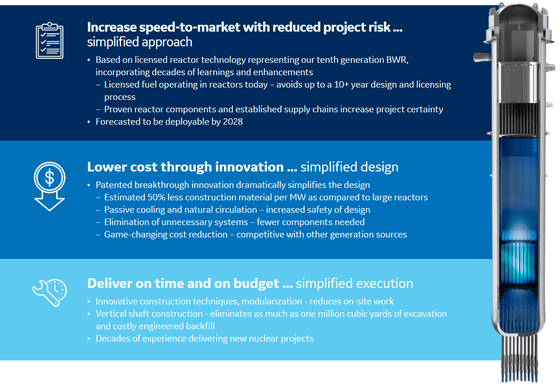Adoption of next-generation small modular reactors, which are expected to be the trump card for decarbonization, is progressing in Canada

Canada's Saskatchewan and Ontario are reported to be deploying GE Hitachi Nuclear Energy 's Small Modular Reactors (SMRs).
Saskatchewan, Ontario to roll out mini-nuclear reactors --Western Investor
https://www.westerninvestor.com/british-columbia/saskatchewan-ontario-to-roll-out-mini-nuclear-reactors-5568249
SMR is a nuclear fission reactor smaller than the conventional reactor, and is being researched and developed in various countries around the world as a 'next generation reactor'. In addition to improving cooling efficiency by making the reactor smaller, it is possible to 'assemble factory-produced reactors locally' by making it modular, which has the advantages of cost reduction until construction and improvement of quality control. It has been.
What is the 'small modular reactor' that is attracting attention as a power generation method for the new era? --GIGAZINE

Of course, since SMR is a nuclear fission reactor, it is safer than conventional reactors, but there is a risk of a nuclear accident. However, in recent years, the supply of energy resources required for thermal power generation has become unstable due to the deterioration of diplomatic relations with Russia, and there is a tendency for 'carbon-free energy' to suppress carbon dioxide emissions that cause climate change. Yes, nuclear power is attracting attention again.
The new SMR ' (PDF file) BWRX-300 ' developed by GE-Hitachi is a light water reactor type SMR, and the output per unit is 300MWe (megawatt electricity), which can supply electricity to about 240,000 households. In particular, it features a system that naturally circulates cooling water to cool the decay heat, and can be cooled for 7 days without power supply or human operation.
The construction cost of the BWRX-300 ranges from C $ 1 billion (about 100 billion yen) to C $ 1.5 billion (about 150 billion yen) per unit. A hydroelectric power generation facility with an output of 1100 MWe is C $ 16 billion (about 1.6 trillion yen) including a dam, and a solar power generation facility that can output 300 MWe with land of 6 to 7 square kilometers and stable sunshine is C $ 300 million (about 300). Considering that it costs 100 million yen), it can be said that the BWRX-300 is quite cost-effective.

Ontario plans to have up to four GE-Hitachi SMRs (300MWe output), and plans to put the first furnace into operation by 2028. Four units can supply enough electricity for the annual energy consumption of about 960,000 households in Ontario, and the construction cost is planned to be 4.8 billion Canadian dollars (about 480 billion yen), which is 4000 Canadian per kW of output energy. It will be a dollar (about 400,000 yen).
In addition, Saskatchewan's electric power company, SaskPower, announced that it is considering introducing the BWRX-300 by around 2035.
Saskatchewan executive Don Morgan said, 'The adoption of the BWRX-300 is an important milestone in Saskatchewan's commitment to a cleaner and more sustainable future. This announcement is from Saskatchewan. We will further promote the development of zero-emission SMR technology, which is the goal of our growth plan. '
Related Posts:
in Note, Posted by log1i_yk






